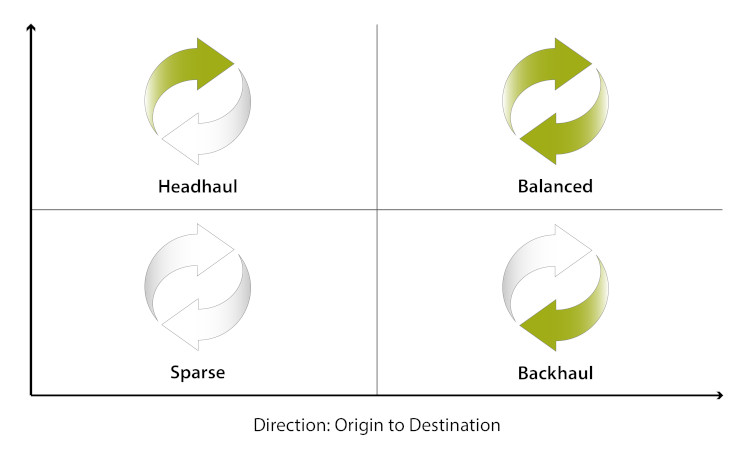Editor’s Note: The SCM thesis Development and Evaluation of Market-Based Routing Guide Strategy was authored by Jorge Oliver and Aaron Zheng, and supervised by Dr. Chris Caplice ([email protected]). For more information on the research, please contact the thesis supervisor.
The truckload (TL) transportation market in the United States is large, fragmented, and highly competitive. Shippers manage their carriers using a routing guide within their Transportation Management System (TMS). The routing guide is the bridge between a shipper’s strategic procurement (usually through a reverse auction or Request for Proposal process) and their tactical execution. It specifies which carrier is the primary for each lane.
Our research examined how routing guides perform across different types of lanes. Specifically, we assessed the “macro-market” and “micro-shipper” effects. The macro-market perspective looks at each lane nationally, considering shipping data across 3 million lanes from TMC, a division of global logistics company C.H. Robinson, and the company’s Procure IQ tool, while the micro-shipper perspective considers only an individual shipper’s volume. For each perspective, a lane can be classified as being in one of four quadrants: Balanced (where there is high volume in both directions), Headhaul (where there is high volume from origin to destination but low volume in the other direction), Backhaul (where there is low volume from origin to destination but high volume in the other direction), and, finally, Sparse (where there is low volume in both directions). The only differences between the macro and micro perspectives are the specific target number for high versus low volume levels and what truckload volumes to consider (all shippers versus just one shipper).

Figure 1: Shipping lane quadrants
Before exploring routing guide performance, however, we needed to establish whether the macro-market classifications were stable over time. Our analysis showed that these lane classifications were very stable at the macro level. We found that 78% of the lanes, defined as a Key Market Area (KMA) to KMA pair, did not change quadrants over the eight years (2015–2022) of market data.
Then, we assessed the routing guide performance for lanes based on the primary carrier acceptance rate. We found no significant variance in performance across the four macro-market categories. However, we discovered a significant difference when examining lanes at the micro-shipper level. Balanced and Headhaul lanes exhibited at least an 8% higher primary carrier acceptance rate than Backhaul and Sparse lanes. This suggests that the shipper’s freight flows influence carrier behavior more than the broader macro-market flows.
This result suggested an opportunity to leverage the macro-market level to improve the routing guide performance for those lanes that are low volume at the micro-shipper level but high volume at the macro-market level. While these lanes only handle about 9% of the volume, they represent over half (about 53%) of the lanes a shipper manages.
Based on our findings, we developed a strategic procurement framework that classifies lanes into four potential relationships that should be part of every shipper’s procurement portfolio.
1. Lanes that are Balanced at the micro-shipper level are characterized as having high and predictable volumes in both directions and should be considered for private/dedicated fleet or contracted capacity.
2. Lanes classified as Headhaul at the micro-shipper level are primary candidates for traditional one-way over-the-road contracts.
3. Lanes that have low volume at the micro-shipper level (Backhaul or Sparse) but are high volume (Balanced and Headhaul) at the macro-market level are candidates for a structured spot pricing strategy where the shipper and carrier agree to set the price per load dynamically based on a mutually agreed upon 3rd party index pricing.
4. Shippers should consider following a traditional market spot approach instead of investing resources in establishing contracts for the remaining lanes.
By applying this strategic procurement framework that considers both a lane’s macro-market and micro-shipper characteristics, shippers can leverage a wider portfolio of relationships that improves their overall routing guide performance while reducing the required effort.
Every year, approximately 80 students in the MIT Center for Transportation & Logistics’ (MIT CTL) Master of Supply Chain Management (SCM) program complete approximately 45 one-year research projects. These students are early-career business professionals from multiple countries, with two to 10 years of experience in the industry. Most of the research projects are chosen, sponsored by, and carried out in collaboration with multinational corporations. Joint teams that include MIT SCM students and MIT CTL faculty work on real-world problems. In this series, they summarize a selection of the latest SCM research.
SC
MR


More TMS
- One door closes, a better one opens
- AI liftoff delayed?
- Procter & Gamble’s Amy Rardin announced as NexGen Supply Chain keynote speaker
- Scaling fast-food warehouse operations in a best-case scenario
- Inflation continues to have a wide-ranging impact on supply chains
- Port of Baltimore May Not Reopen Until Summer
- More TMS
Latest Podcast

 Explore
Explore
Topics
Procurement & Sourcing News
- AI-driven sourcing: Why the speed of change is going to only accelerate
- A Silk Road city
- U.S.-bound containerized import shipments are up in June and first half of 2024
- Boeing turned to Fairmarkit, AI to help land its tail spend
- When disaster strikes, the supply chain becomes the key to life
- A smarter approach to sustainability is vital for healthy, resilient supply chains
- More Procurement & Sourcing
Latest Procurement & Sourcing Resources

Subscribe

Supply Chain Management Review delivers the best industry content.

Editors’ Picks




